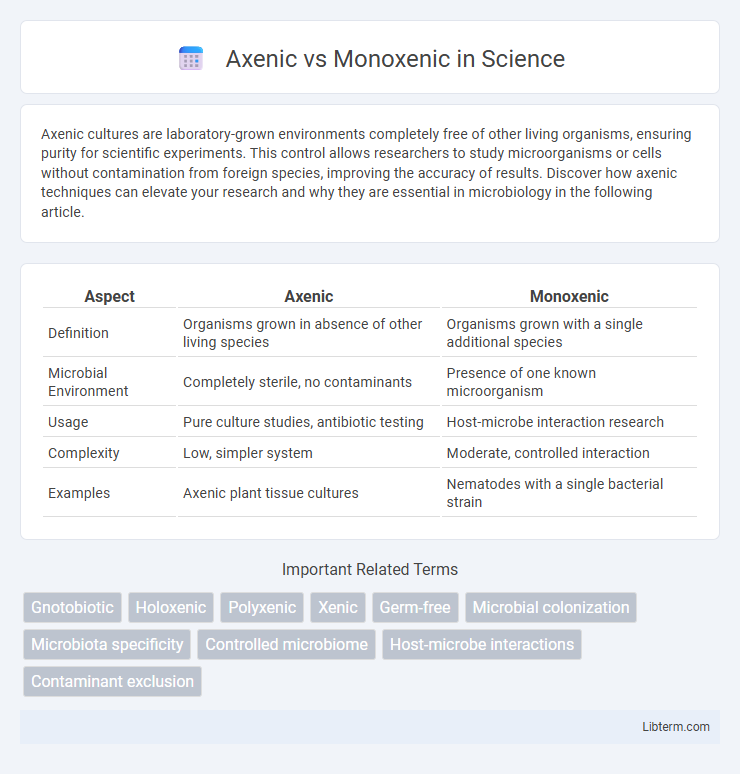Axenic cultures are laboratory-grown environments completely free of other living organisms, ensuring purity for scientific experiments. This control allows researchers to study microorganisms or cells without contamination from foreign species, improving the accuracy of results. Discover how axenic techniques can elevate your research and why they are essential in microbiology in the following article.
Table of Comparison
| Aspect | Axenic | Monoxenic |
|---|---|---|
| Definition | Organisms grown in absence of other living species | Organisms grown with a single additional species |
| Microbial Environment | Completely sterile, no contaminants | Presence of one known microorganism |
| Usage | Pure culture studies, antibiotic testing | Host-microbe interaction research |
| Complexity | Low, simpler system | Moderate, controlled interaction |
| Examples | Axenic plant tissue cultures | Nematodes with a single bacterial strain |
Introduction to Axenic and Monoxenic Cultures
Axenic cultures consist of a single species or strain of microorganism, providing a controlled environment for studying specific microbial behaviors without interference from other organisms. Monoxenic cultures involve one primary microorganism along with one other associated organism, often used to explore symbiotic or pathogenic interactions. These culture methods are essential in microbiology for investigating microbial physiology, genetics, and ecology under defined conditions.
Defining Axenic Cultures
Axenic cultures consist of a single, pure species of microorganism grown in a sterile environment free from any other living organisms, ensuring no contamination. These cultures are essential for studying specific microbial physiology, genetics, or biochemical processes without interference from other species. Axenic cultivation contrasts with monoxenic cultures, where a single host organism harbors one specific symbiont or microorganism, but unlike axenic cultures, they are not necessarily free from other contaminants.
Defining Monoxenic Cultures
Monoxenic cultures are microbial cultures that contain one specific microorganism species along with a single, known associated organism, typically a symbiont or host. This contrasts with axenic cultures, which are completely free of any other living organisms except the one species being studied. Monoxenic cultures are crucial for studying interactions between microorganisms and their hosts under controlled laboratory conditions.
Key Differences Between Axenic and Monoxenic Systems
Axenic systems involve the cultivation of organisms in a completely sterile environment, free from any other living microorganisms, ensuring pure culture growth. Monoxenic systems include a single known microorganism alongside the host or primary culture, allowing interaction with only one symbiotic or parasitic species. The key difference lies in sterility, with axenic systems being entirely microbe-free, whereas monoxenic systems maintain a controlled association with exactly one additional microorganism.
Advantages of Axenic Cultures
Axenic cultures provide a sterile environment free from contaminating microorganisms, allowing precise control over experimental variables and reproducibility in microbiological studies. These pure cultures facilitate accurate assessment of specific microbial traits and responses without interference from other species. Axenic systems are essential for producing consistent biomaterials and pharmaceuticals, ensuring safety and quality in industrial applications.
Benefits and Challenges of Monoxenic Cultures
Monoxenic cultures, involving one host and one microbial species, offer benefits such as controlled study of host-microbe interactions, improved consistency in experimental results, and reduced contamination risks compared to complex microbiomes. Challenges include difficulty maintaining stable symbiotic relationships, susceptibility to environmental fluctuations, and limitations in mimicking natural ecosystem complexity. These factors require precise management to optimize monoxenic culture systems for applications in microbiology and biotechnology.
Applications in Microbiology and Biotechnology
Axenic cultures, consisting of a single microbial species, enable precise study of organism-specific functions crucial for biotechnological advancements such as antibiotic production and genetic engineering. Monoxenic cultures, involving one host organism and one microbial species, provide insights into host-microbe interactions essential for developing biocontrol agents and symbiotic nitrogen fixation. Both culture types are fundamental for isolating microbial metabolites, optimizing fermentation processes, and advancing microbial ecology research in agriculture and pharmaceuticals.
Methods for Establishing Axenic and Monoxenic Cultures
Axenic cultures are established by isolating a single microorganism and using sterilization methods such as autoclaving, filtration, or antibiotics to eliminate contaminants, ensuring a pure, contaminant-free environment. Monoxenic cultures involve isolating one primary microorganism alongside a single symbiotic or associated species, often achieved using selective media and controlled environmental conditions to maintain both organisms. Techniques like serial dilution, streak plating, and micro-manipulation are common in establishing both culture types, with axenic cultures requiring more rigorous sterile protocols to prevent microbial contamination.
Common Contamination Issues and Prevention
Axenic cultures are completely free of contaminating microorganisms, while monoxenic cultures contain a single known microorganism alongside the host. Common contamination issues include bacterial, fungal, or viral intrusions that compromise the purity and experimental integrity of both culture types. Prevention strategies emphasize sterilization techniques such as autoclaving media, using antibiotics selectively, maintaining aseptic work environments, and regular monitoring through microscopy and molecular assays.
Future Trends in Axenic and Monoxenic Research
Future trends in axenic and monoxenic research increasingly emphasize advanced genomic and metabolomic techniques to better understand microbial interactions and isolate pure cultures for biotechnological applications. Innovations in microfluidics and single-cell analysis enable precise control and observation of microbial environments, accelerating discoveries in synthetic biology and drug development. Integration of AI-driven data analytics is poised to enhance predictive models, optimizing cultivation strategies and fostering breakthroughs in environmental and medical microbiology.
Axenic Infographic

 libterm.com
libterm.com